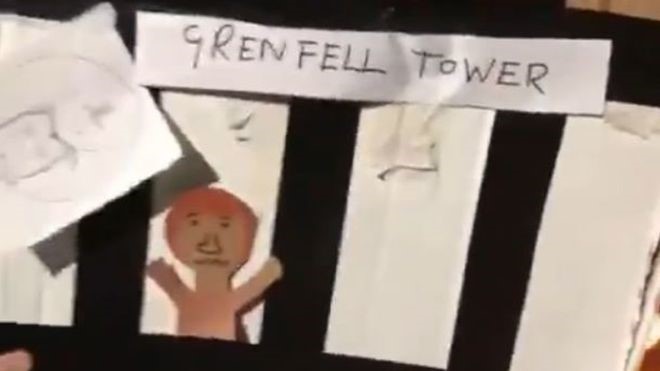The Gryphon considers whether the burning of the Grenfell Tower effigy is potentially a hate crime.
Whilst Thousands of families and friends gathered to enjoy the dazzling fireworks and impressive bonfires last week, a video conveying one horrific bonfire, in particular, repulsed the nation.
Six men aged between 19 and 55 were arrested on suspicion of violating Section 4a of the Public Order Act following the burning of a Grenfell Tower effigy which circulated on Twitter attracting worldwide condemnation.
These arrests have since pondered the question, how do we differentiate between hate crimes and simply distasteful jokes. The offence that the 6 men were brought up on is, simply put, ‘intentional harassment, alarm or distress’ which, if prosecuted, can land a person a large fine or indeed two years in prison. Legal experts have however already explained how they doubt this case will be pursued due to its complexity in proving it to be ‘intentional’. It was carried out in an enclosed space as well as being mere ‘entertainment’ for themselves as opposed to being purposely posted online. Nevertheless, a violation of the public order act isn’t the only potential charge, and Grenfell campaigners among others, see a potential hate crime case.
As sickening as the video is in its representation of the atrocity, the attention to detail makes it more chilling. The offenders knowingly included paper copies of people trapped in the building, adding to the odious and hateful nature of the video. These paper copies, however, are deliberate representations of ethnic minorities, who were set alight in the clip, mimicking the tragic losses. By definition, a hate crime is: ‘a crime motivated by prejudice’, and it was no coincidence that the figures in the video were people of darker skin, one of which, was wearing a niqab for example. Out of the 72 victims, including a stillbirth, who tragically perished in June 2017, almost 90 per cent of people were of a different ethnicity. In the disgusting video, the niqab figure is referred to as ‘a ninja’ who is ‘getting it’ and others cry ‘help me’ whilst the odious men claim ‘that is what happens when you don’t pay your rent’. These remarks, in the opinion of most, are evidently prejudicial, and somewhat racist. In this instance, the prosecutors may not be able to prove it to be a violation of The Public Order Act, however, openly racist remarks can obtain, at the very least, a large fine, or at most, time behind bars- and Justice for Grenfell claim that the video ‘incites racism’.
The campaign has been unsurprisingly vocal in condemning the evil clip. In a statement, they expressed: ‘we are disgusted and shocked at the inhumanity and callousness of those involved in this video’ ‘this is clearly a hate crime’ and ‘a sickening act of hate’. Amongst others to condemn the vile clip include the London Fire Commissioner Dany Cotton, who actively fought the fire, stating that ‘to intentionally use and mock the Grenfell Tower fire in this way will cause deep pain and offence to the bereaved, survivors, the local community and all of the emergency services who will never forget that night. It cannot be justified on any level.’
Prime Minister Theresa May, who has been heavily scrutinised for her neglect of the Grenfell Tower case also took to Twitter to express her disgust, referring to the footage as ‘utterly unacceptable’. Chief of the Grenfell Enquiry, Sir Martin Moore Bick adopted a more positive stance, in stating he is ‘pleased the authorities are taking the matter so seriously’.
There is, however, the likelihood that this case is dropped. Many have disputed the need to so heavily persecute this particular case. It ponders the question, ‘should the police, who are already under-resourced, pursue an evil joke, when other crime rates are so elevated’. Many people believe, and perhaps correctly, that social media is full of distasteful jokes and crude humour, and that it is just the freshness of this atrocity that makes this one so despicable. In another broader interpretation, if we cross the Channel to France, for example, Satirical Magazine ‘Charlie Hedbo’ publishes constant controversial material provoking complete outrage every week. Indeed, it has reaped its own tragic consequences for its controversy, (for example the January 2015 terror attack) yet it continues to publish and sell millions of copies. Of course, humour and legislation in France are very different, but it leaves some wondering how to differentiate between distasteful jokes and genuine criminal offences. Furthermore, Effigies in the past have indeed attracted heavy controversy and often retaliation, but never a criminal case. Lewes in Essex, for example, is notorious for its famous effigy burnings that take place every year, often politicians such as David Cameron, Kim Jong Un, Vladimir Putin and Angela Merkel, yet some as controversial as the Pope. Burning an effigy of the Pope, officially, under the law can be considered as a Hate Crime, but it went unpunished, despite the outrage it provoked. Therefore, prosecution for the horrendous Grenfell effigy could be contradictory standard, in spite of the disgusting rhetoric demonstrated in the video.
The extreme behaviour conveyed in this video will completely change the lives of the alleged perpetrators. Their names, faces, ages have been slapped in every news publication and website, showing the profile of 6 odious men. Whether the case is pursued, and they’re prosecuted (which, for most, would be justice served) or they walk away free, the response of the country has really conveyed a solidarity in support for the victims of the tragic fire. It has too, however, incited nationwide discussion on humour and hatred, and how they can be so different, but ever so closely related.
Dylan Kane

